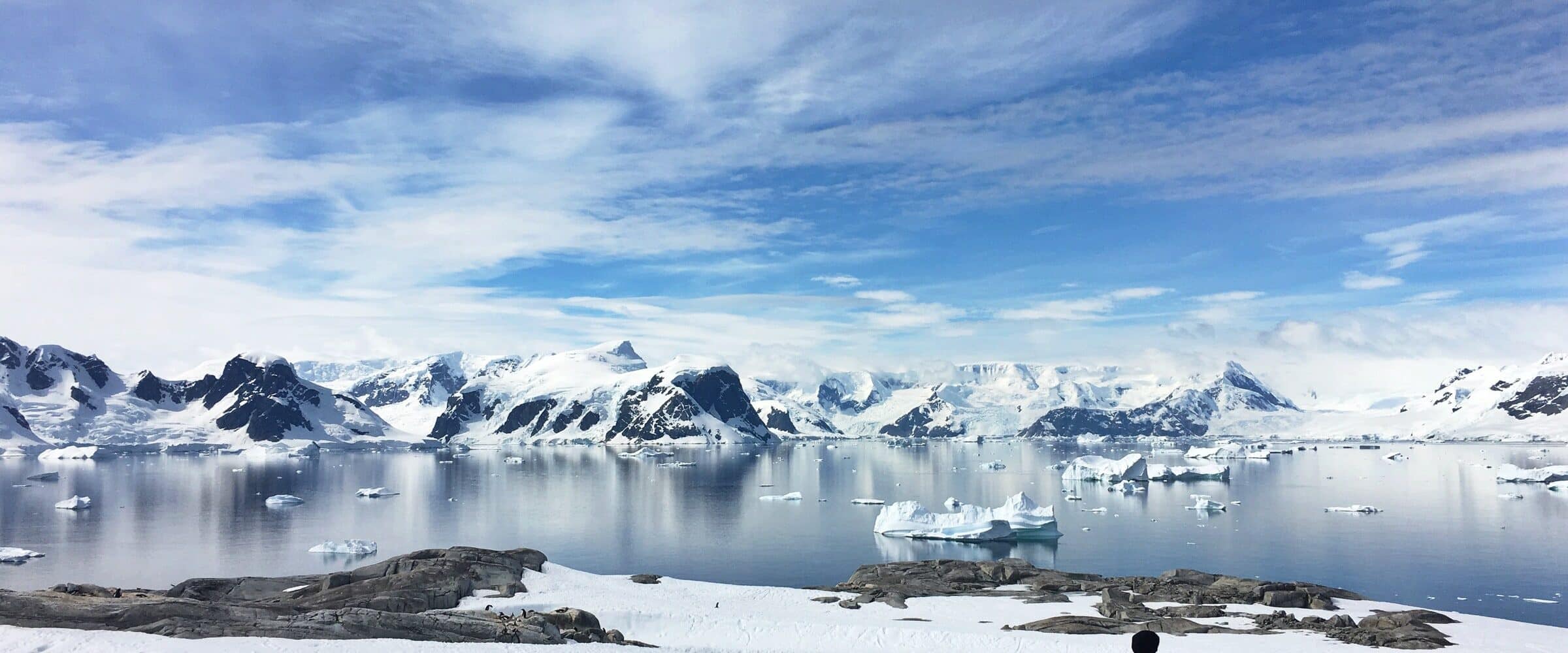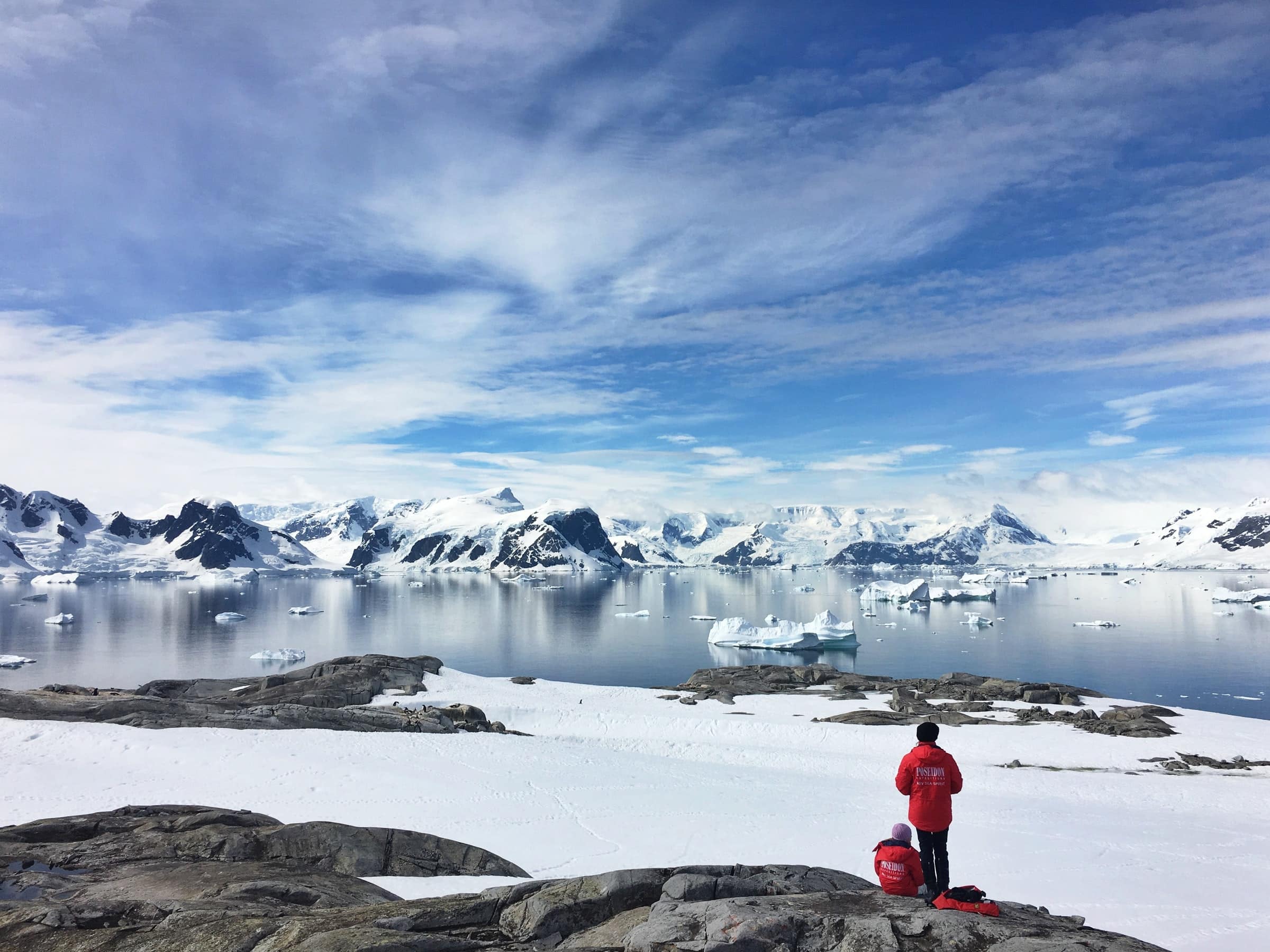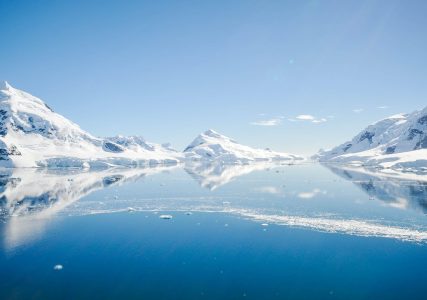With an area of nearly 14 million square kilometers, the Antarctic ice sheet is not only almost 1,5 times larger than the continent Europa, also it is the largest ice mass on Earth. Antarctica is huge, almost twice the size of Australia. With ice up to 4 kilometers thick in some places, it is an unprecedented cold and wild place on this globe. The frozen planet BBC series has inspired many people to go to Antarctica and see it for themselves. Exploring the icy waters with a Zodiac boat, to walk on a continent where few people have set foot. To experience nature in all its glory, to spot animals that defy the elements. Antarctica is one of the last truly wild places on Earth.
History Antarctica | The Race to the South Pole
Then Robert Peary claimed to have reached the North Pole in 1909, he caused a dramatic race among polar explorers to be the first to reach its southern counterpart. On December 14, 1911, the Norwegian explorer Roald Amundsen and his team after months of preparation the first to finally reach the South Pole and claim victory for Norway. Amundsen and his team were just five weeks ahead of a British side led by Robert Falcon Scott as part of the Terranova Expedition, an expedition that unfortunately resulted in the death of Scott's entire group.
Antarctica Movies
If you're looking for something visual to spark your Antarctic wanderlust, there's a whole world of movies and TV shows to feast your eyes on. We definitely recommend looking at:
Our Planet – Frozen Worlds
In Our Planet's episode “Frozen Worlds” you get to see images of both the North and South Poles. But because this is one of the best and most beautiful documentaries with images of Antarctica and because it is available completely free of charge via the YouTube channel of NetFlix, we cannot leave it out. The commentary in this documentary film is by none other than David Attenborough, best known for the Planet Earth documentaries. Sit back, full screen, cup of tea, high quality images and enjoy.
Shackleton
Directed by Charles Sturridge, this film tells the story of Shackleton's 1914 polar expedition to the South Pole. After his ship is crushed by pack ice, Shackleton (played by Kenneth Brannagh) must cross ice, cross 800 miles of water and climb mountains to find help and rescue his crew. Follow in Shackleton's footsteps by joining an Alpine Crossing excursion on this 20-day Falklands, South Georgia & Weddell Sea Voyage and try to repeat Ernest Shackleton's epic crossing from King Haakon Bay to Stromness for up to three days. The crossing distance is 20-30 miles, depending on the route, and involves crossing large glaciers with high crevasses and mountain passes.
March of the Penguins
A fantastic film released in 2005 and narrated by Morgan Freeman about the incredible struggle the Emperor Penguin faces to reach its annual nesting site and raise its young. The film was shot for an entire year by two isolated French cinematographers who, like the penguins, had to endure the incredibly harsh Antarctic winter.
frozen planet
Narrated by David Attenborough, this remarkable BBC wildlife documentary series was extremely well received when it aired in October 2011, thanks in large part to the fantastic photography and close-ups of some of the world's most remote wildlife. Frozen Planet consists of 7 episodes and explores the life and environment of both the North Pole with the changing of the seasons.
Antarctica Travel Videos
Of course it is also very nice to travel videos looking over Antarctica. The video at the top of this page gives you beautiful, dreamy images of this unique continent in 2 minutes. For those who want more information and really want to experience a day on an Antarctic cruise, I recommend to watch this nice candid video of Kara and Nate, 2 well-known world travelers who report on a day on an Antarctic cruise ship where they stayed for 2 weeks.
Books about Antarctica
If you'd like to get a taste of Antarctica's history, before or during your trip to Antarctica, we've compiled 3 of our favorite books from the point of view of scientists, historical explorers, and adventure travelers:
- Unknown land by Sara Wheeler – Follow Sara Wheeler on her adventure in the Antarctic Artists and Writers Program as she shares her vision of Antarctica from the early research era through Antarctica's heroic and modern history. Wheeler writing is witty and intelligent, and she successfully weaves her own exploration and experience of Antarctica with the history of the Great White Continent.
- End of the Earth: Voyaging to Antarctica by Peter Matthiessen – Widely regarded as America's greatest literary naturalists, Peter Matthiessen charts his Antarctic expeditions in 1998 and 2001, where he describes and reports on the penguins, seabirds and marine mammals he hopes to see while in Antarctica. What Matthiesen does best is not only paint a beautiful picture of a remote place that few people visit, but also frame his concerns about protecting the environment.
- Scott of the Antarctic by David Crane – Republished in 2012 to mark the 100th anniversary of Captain Scott's doomed mission, this beautifully written biography aptly chronicles Scott's infamous expedition to the South Pole and examines the man behind the tragedy, his courage and resilience that made him one of Britain's greatest explorers.
Wildlife in Antarctica
Antarctica is home to a truly astonishing array of marine life, including eight species of penguins that nest or breed in and around the continent. Among them you can see the Emperor, Chinstrap, King, Rockhopper, Macaroni, Gentoo and Adelie. The waters off Antarctica are also home to minke and humpback whales, which can often be seen around Neko Bay. Seals are common, including the elephant, crabeater, fur, leopard, and weddell species.



Weather and seasons in Antarctica
The seasons in Antarctica are essentially the opposite of ours, summer starts in November to March and winter takes over from March to September. The intervening months are similar to our fall, although the ice is too thick for ships to explore with passengers, making the visiting season quite short.

During the summer months of Antarctica you can expect up to 24 hours of daylight which makes it a very special and surreal experience, but during the winter and especially at high altitude in June Antarctica is shrouded in 24 hours of darkness, and it is definitely time to try the continent's wild animals, who must survive this seemingly endless cold.

As a general rule, in Antarctica the temperature drops as you leave the coast and the continent slopes upward where the temperature drops. If you come from November to February, you can expect temperatures of around -27,5 degrees that drop to -60 degrees in winter. So don't forget your thermal underwear!
Travel to Antarctica
Antarctica is finished fourth largest continent in the world, but most cruises focus on the Antarctic Peninsula (the pointy part) rather than going too far inland. The peninsula is dotted with a slew of important landmarks, named for the hundreds of polar explorers who tried to conquer this inhospitable land in the 19th and 20th centuries, even to this day.
Many Antarctic cruises cross the Drake Passage and explore the South Shetland Islands and the northern Antarctic Peninsula, while others continue across the Antarctic Circle 66 degrees south, as far as Marguerite Bay.

Some cruises based outside of Ushuaia or Punta Arenas will go as far south as the Ross Sea, or have you head inland to the South Pole, although some special expeditions are designed to do this. It is also possible to reach the Ross Sea on a cruise disembarking in New Zealand.
All trips to Antarctica are flexible to circumstances, which is all part of the adventure of traveling this far south!
The 5 different regions of Antarctica
1. Antarctic Peninsula
If you want to set foot on mainland Antarctica, feel the cold air on your cheek, observe the hilarious antics of penguins, and explore some of Antarctica's most beautiful spots, a peninsula cruise is the classic way to experience Antarctica.
what are you going to see – Prepare for sensory overload. During the day, ride rubber zodiacs to cruise between towering icebergs, visit huge penguin colonies, and admire ice floes. Spot wildlife as you anchor overnight in a quiet cove, ready for the next day's adventure.

Cruises – sailing between the end of October and the end of March. Each month has its own characteristics and nuances, so there is no real 'best time' to visit, but there is a peak season and a shoulder season.
The high season – is late December to early February, when the days are long, the weather is most stable and wildlife most active. However, spring (late October and November) has a lot to offer, with heavier ice and the chance to be one of the first to go to Antarctica that year. Later in the season, the softer light of March is great for photographers and you have a greater chance of seeing whales.
2. Antarctic interior and South Pole
The interior is a sprawling, pristine playground visited by fewer than 500 people each year. Fly or ski to the South Pole, climb Mount Vinson, camp among emperor penguins, hike waves of blue ice or simply take your time to watch the light change on the sastrugi knowing you are in one of the most remote places on Earth. is located.
Mountaineering – Antarctica offers an extraordinary opportunity to climb the most remote places on Earth, from the continent's highest peak, the Vinson Massif, to the highest volcano, Mount Siddley. In addition to the well-known peaks, there are plenty of opportunities to explore, guided by expert expedition leaders.
Walk of the Penguins – The Emperor Penguin is arguably one of the most recognized species on Earth. One of only two true Antarctic penguins (along with adelies), their extraordinary breeding cycle has been immortalized by many Attenborough documentaries and, most famously, the movie March of the Penguins.

There are only a handful of ways to see these creatures in the wild, making the Antarctic outback a must for anyone who wants to find them. Two breeding colonies are allowed for visitors, Gould Bay and Akta Bay, both about 70 miles from the shoreline, accessible only by specially modified aircraft.
Reaching the South Pole – The holy grail of terrestrial exploration, reaching the South Pole is the ultimate prize for explorers and adventurers alike. Cross international data and timelines in moments by walking over the points where all longitude lines converge.
For those to whom these things are important, there are actually two South Poles, the ceremonial and the geographic. You can visit both on foot, by car or by plane, and you can also visit the US Scientific Research Base and the Amundsen – Scott South Pole Station.
3. South Georgia
Due to its sheer density of wildlife, majestic landscapes, compelling history, and remoteness, South Georgia is hard to beat in any of these categories. It is one of the least visited places on Earth, but the time and effort invested in getting there is rewarded with rich dividends.

Wildlife – At the height of the breeding season, there is said to be more wildlife per square foot here than anywhere else on the planet. South Georgia's prodigious wildlife includes penguins, birds, whales, and seals, and the numbers are nothing short of staggering. Their lack of fear of humans also makes them incredibly curious, this is one of the best places in the world to be approached by a curious penguin, or laughing seal.

The diversity – this small island makes it one of the more spectacular places to visit in Antarctica. From a colony of 300.000 king penguins in St Andrews Bay to Gold Harbour, where the sun's rays bathe hanging glaciers to make them glow yellow and orange, the scale of opportunities for spotting wildlife and admiring the scenery is unparalleled.
This is also one of the richest places for history – the sleepy village of Grytviken shelters Sir Ernest Shackleton's grave, and you can even follow in the man's footsteps on the Shackleton Walk, from Fortuna Bay to Stromness where he sounded the alarm in 1916 .

Best time to travel – The visitor season is limited to the end of October to March. During these months the weather is more favourable, but still very unpredictable! As a rule, November and March are colder, but the softer light is favorable for photographers. More important are the nuances between the wildlife.
Fighting elephant seals make for great drama and photo opportunities in November. Due to the sheer density of animals, certain landings in December can become a real challenge. In January, Prion Island is a favorite with bird watchers for its albatross.
4. Falkland Islands
The Falklands may be a small, remote and sparsely populated archipelago, they far surpass its small size when it comes to wildlife, varied landscape and the friendliness of the islanders who call this island outpost 'Home'.
Wild animals – It is true to say that if the Falkland Islands were easier to get to, they would receive significantly more visitors each year, especially to see the island's impressive wildlife. The birdlife alone – 227 known species – is incredibly diverse for such a small area, making it a birding mecca.
Falkland Penguins – The chance to see up to 5 of the world's penguin species – donkeys, magellanic, macaroni, rockhoppers and king – is also a big draw. The sight of small groups of magnificent kings marching along empty white beaches is unique and makes for great photo opportunities.

And then there are sizable populations of lounging sea lions, giant elephant seals drawn among the tussock grass, and whales and dolphins galore off the coast.
Statistics aside, what makes the Falklands wildlife so special is how accessible they are; it is far from uncommon for the patient observer to be approached by a curious penguin or a curious caracara.
Falkland Wolf – Although sadly now extinct, the Falkland Wolf or 'Warrah' has a fascinating history. Described by Darwin as a wolf-like dog, the 'Warrah' was the only predator on the islands. They were hunted for their fur by settlers on the island and poisoned by farmers who saw them as a threat to their sheep. The Falkland Islands wolf went extinct in the 1870s and its closest living relative is the maned wolf, a rare canid that roams the grasslands of South America.
Landscape – The landscape consists of two main islands – East and West Falkland – but with a total of 776 islands, the closest neighbors to this isolated Atlantic archipelago are Patagonia, 483 kilometers to the east, and South Georgia.

Scenically, there is nowhere else quite like The Falklands. Sparsely populated, unspoilt, raw and diverse are the words that best sum up the island's landscape. Perfect white sand beaches, rolling golden hills, towering cliffs, rocky promontories and unique 'stone descents' that flow like rivers through the mountains offer a small window into the surprising geographical diversity of what you will find.
Weather and climate – The Falklands have a cold maritime climate, influenced by the Antarctic Current, although mild compared to Antarctic temperatures.
Winter temperatures (May – September) fluctuate between 0 and 5 °C, while wind and rain are common, snow much less. During the summer months, the temperature averages 9°C, with November to February being the most favorable months. When warm air flows over the sea, temperatures can reach around 15°C. Summer days can be clear and dry or wet and windy, or both; the weather is known for its changeability.
5.Ross Sea
The southernmost sea on Earth is remote, hauntingly beautiful and has fascinating historical significance. A hidden gem off the Antarctic tourist trail, the Ross Sea remains as mystical as ever, welcoming only a lucky few to its frozen shores every year.
what you will see – The spectacularly stunning sub-Antarctic islands, which receive only a handful of visitors a year. Each island is unique, from the huge wildflowers on Campbell Island to the rugged Snares Islands and the imposing windswept cliffs of the Auckland Islands. Expect to be out and about, cruise the coastline in zodiacs and set up your camera on the beach for the perfect penguin photo.
On reaching the Ross Sea, put on your boots each day to explore the coastline, including Ross Island itself with its imposing volcano, Mt Erebus. You can also visit the Ross Ice Shelf, the world's largest body of floating ice, to gaze at the huge 30-foot (XNUMX-meter) high ice cliffs.
Wild animals – It may be remote, but this region is absolutely teeming with animals and birds, and is nothing short of a nature lover's paradise. Observing nature will be a big part of your trip; look out for southern right whales, petrels, parakeets, emperor penguins and albatrosses, share beaches with elephant seals and rare New Zealand sea lions, and walk among bustling colonies of king, royal, rockhoppers and gentoo penguins.
Cape Adare also has Antarctica's largest Adelie penguin colony, something of a sensory overload for both the nose and eyes. A chattering, bickering, waddling mass of black and white, these birds are wildly curious and charmingly friendly.
History – At the turn of the 20th century, this part of Antarctica was the bustling epicenter of Heroic Age discoveries. The race to the South Pole had begun, and the huts used by the pioneering explorers are incredibly well preserved. From food rations to clothing, candles and bedding, entering these huts is a step back in time, a fascinating insight into the scientific endeavors and hardships faced by the explorers.

Scott's Hut was a research base during the Discovery Expedition, a milestone in British Antarctic exploration that aimed to make Scott a national hero. Shackleton's Hut was the base for the ill-fated Nimrod Expedition, where the team came within a tantalizing 100 miles of the South Pole before Shackleton made the historic call to return for the safety of his men.
How do you get there – There's a reason the Ross Sea is a bit of an exclusive destination, because you have to be able to block a month in your diary to explore it. The trips here are considerably longer than the average trip to the Antarctic Peninsula, often 30-35 days, but if you have the time it's a real trip off the beaten track.

Due to its location on the edge of Antarctica, voyages to the Ross Sea begin on New Zealand's South Island, rather than Argentina or Chile. Christchurch is the nearest international airport and internal flights connect with Auckland on the North Island.





